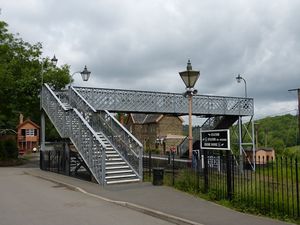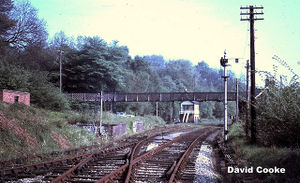Highley Station Footbridge
The present Highley Station Footbridge was constructed in 2009. It replaced a longer footbridge on the same site which was deemed beyond economical repair and demolished for scrap in spring 1974.
Contents
Design
GWR footbridges followed two basic styles. That of the 1880s is reflected in the footbridges at Bridgnorth & Bewdley with cast iron columns. The present footbridge at Highley is intended to mimic the more utilitarian style of the early 1900s.
Original Highley Footbridge
The bridge continued in use until BR ended passenger services in 1963, after which its condition deteriorated. When the SVR acquired this portion of the line at the end of 1972, they reluctantly deemed the bridge unsafe and demolished it on 11 April 1974, at the same time as repairs to the Underbridge on Station Road, Highley were being carried out, just before the reopening of services to Highley on the following Easter weekend.
Present Highley Footbridge
By 17 November 2008 the funding package and design were in place to construct a new footbridge which that year's service, following the opening of the Engine House, had shown was much needed. The European Regional Development Fund and Advantage West Midlands provided funding for this project. The style of the new footbridge reflected that of the earlier footbridge. However at the end nearer the platform it was no longer necessary (or indeed possible) to access the barrow crossing directly, and therefore only a single flight of steps to the platform was required. Steps were included at the west end as the likely use was mainly for passengers visiting the Engine House rather than Highley Village. This resulted in a shorter span of 45ft 6in.[2]
Work to install the bridge began at that time and caused an element of disruption to services; no services stopped at Highley Station through November and December weekends (apart from Boxing Day to 4 January 2009) to allow piling work for the installation of the foundations and bridge support pillars.[3] The closure continued for another four weekends in January while this work was completed.[2]
Delays in construction
The originally intended installation date was 10 April 2009. This date was missed, with the General Manager reporting in May that it was primarily due to the fabricator underestimating the complicated nature of the construction of the main span. Whilst the main stairwells were complete the main span still needed considerable work to complete. With the main running season underway the decision was taken to delay the installation until September/October giving sufficient time for the main span to be completed to a high standard. The installation could then take place during daylight hours when the line is clear.
Erection of the bridge eventually took place on Monday 12 October 2009. D8188 brought the main span and stairwells by rail to the site, where they were lifted into place by the 30-ton steam crane.[4] The bridge opened for public use from 24 October to 1 November 2009 before closing for a few days to enable final detailing work to take place.
Formal opening
The footbridge was formally opened by SVR Patron HRH The Duke of Gloucester on 21 October 2009, on the occasion of his visit to the the newly-opened Engine House. The bridge carries a plaque to mark this event.


